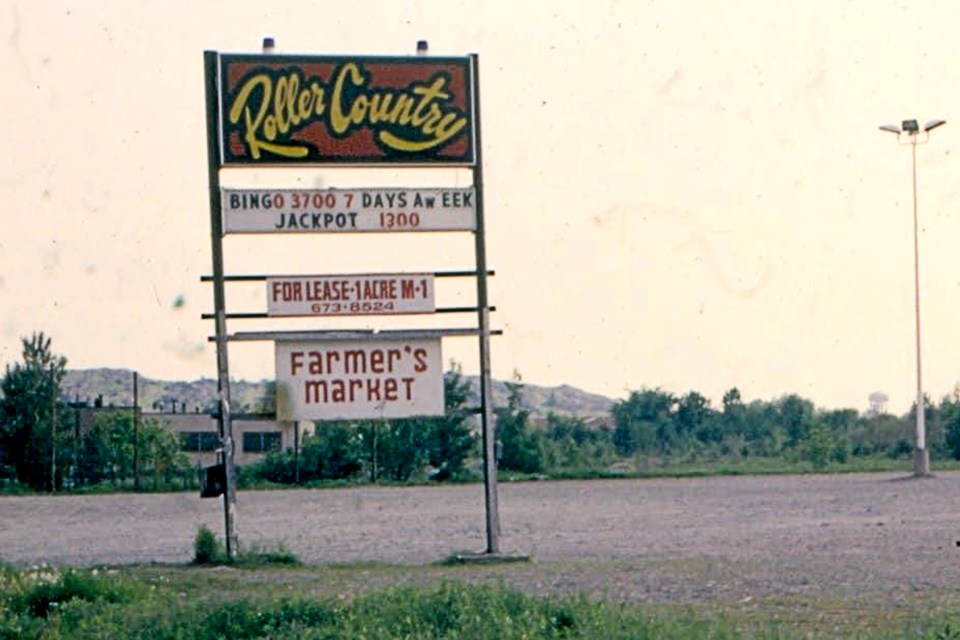As you are travelling north on Notre Dame, after crossing the train tracks that divide the Flour Mill from Cambrian Heights, you will find a collection of businesses on the western side of the road.
Among them is a “Country” dedicated to the favourite pastime of many, “Sleep” — yes, Sleep Country is what I’m referring to. But, if we were to go back in time, we would find a vastly different “Country” in this location. A “Roller Country,” which, for a time, allowed many to enjoy a much less sleepy pastime.
For an activity shaped so much by mid-20th century pop culture and style, the story of roller skating, in fact, dates back all the way to the 18th century when the first roller skates were invented. These early skates were a far cry from the sleek and comfortable designs which evolved later. They featured wooden wheels and a metal frame, which often made them a challenge to control, presenting a unique set of challenges for those brave enough to try them out.
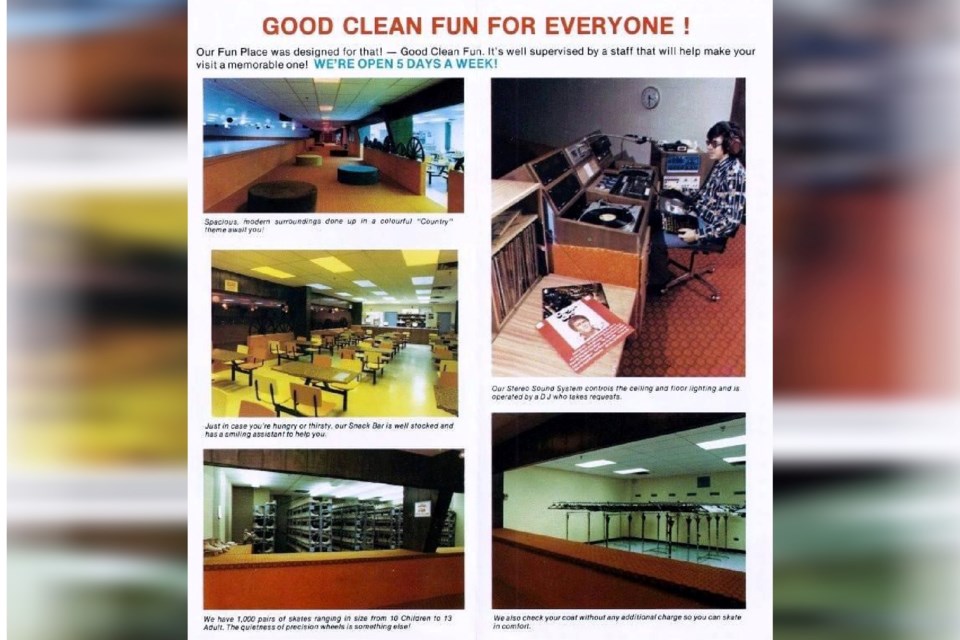
Now, fast forward to the 20th century, where roller skating finally began to gain widespread popularity. Roller rinks started to pop-up all over Canada and the United States, becoming social hubs for their communities. These rinks featured smooth, polished floors and offered a safe environment for skaters of all ages and skill levels to enjoy their favourite activity.
Roller rinks became the place to be for family outings, dates, and social gatherings, and they played a pivotal role in the shaping of roller-skating culture.
In the 1970s, roller skating took on a life of its own with the advent of the roller disco. There was nothing more quintessentially 1970s than when this phenomenon swept across North America during the latter half of the decade. It had it all: gaudy styles, flashing lights, mirror balls, and (of course) disco music.
Roller discos became the place to see and be seen, with skaters donning flashy outfits and showcasing their dance moves on wheels. It was a roller-skating renaissance, and it left a lasting impact, turning this hobby into as much spectacle as sport.
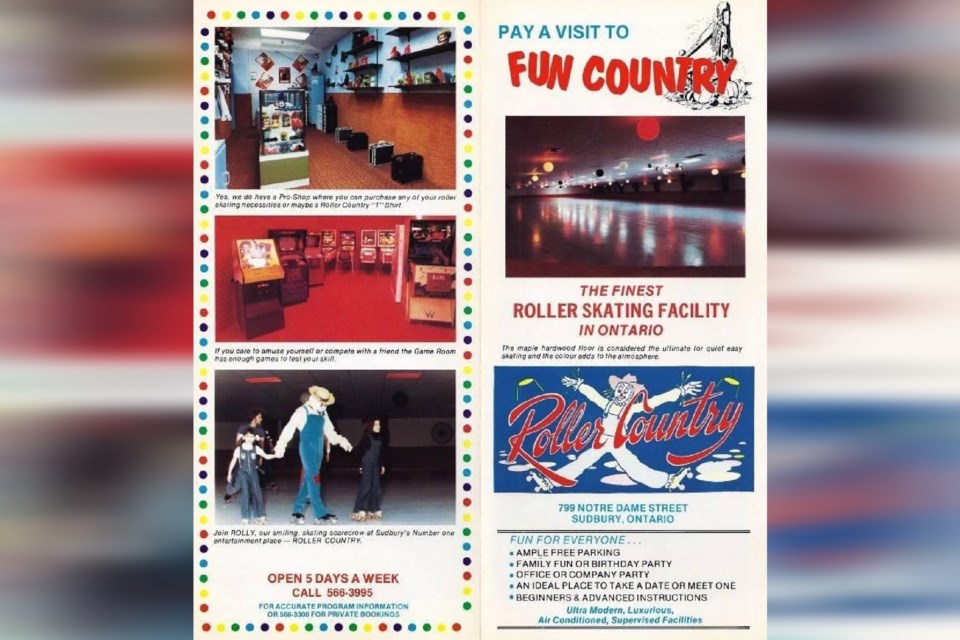
This is where our story begins, so strap on your roller skates and let’s head on down to the rink, for (to borrow a tagline from that roller-skating-centric cinematic crime “Skatetown USA”) - “The Greatest Story Ever ROLLED.”
In July 1976, the local newspaper announced (much to the delight of local youths) that a year-round roller-skating rink for the city was entering the planning stages. The four owners of this new venture — Bud Burke, Joe Drago, Norm Forest and Len Yauk — saw a niche that needed to be filled. This led to the decision to invest their money and devote their time to the construction of an entertainment mecca for the local roller-skating loving youngsters of Sudbury.
In December of that same year, after many months of hard work, what started out as a vacant lot along Notre Dame was transformed into Sudbury's newest leisure attraction, “Roller Country.” The city was on the verge of succumbing to “roller fever.”
The registered capacity for this new venture was 800 skaters who had 1,000 pairs of skates from which to choose (at a rental cost of 75 cents, no less). Upon its inauguration, the admission fees were announced to be variable depending on your “qualifications” as well as the day that you wanted to skate.
Now close your eyes and we can step back in time.
The skating surface at Roller Country was comparable to a professional hockey-sized rink, measuring 86 feet by 182 feet of highly polished wood. The perimeter boards of the roller rink were carpeted with orange shag and the floors around the rink proper were covered with a patterned carpet (also in orange tones).
And, unlike the bright lights of its colder brethren, this rink was lit by coloured globe lights and mirror lights all along the ceiling as well as smaller lights around the sides. Of course, these lights could be fully appreciated on Disco Night as they were hooked up to the sound system, from which the DJ would be blasting the latest grooves.
By April 1977, five months after its opening on Dec. 14, 1976, Roller Country had already welcomed more than 150,000 roller skating enthusiasts through its doors and onto its smooth plywood surface. It was, as stated in print advertisements of the day, “A clean friendly place to enjoy your evenings and weekends”.
Looking back from our 21st century vantage point (balanced with a diet of copious amounts of Seventies pop culture), a fascinating aspect of Roller Country are the regulations that were imposed on those wishing to flex their roller-skating muscles while out with friends.
These regulations were written about extensively in the local news (oddly enough) and were what, according to management at the time, made them the best place for parents to leave their kids for recreation during an evening (or afternoon).
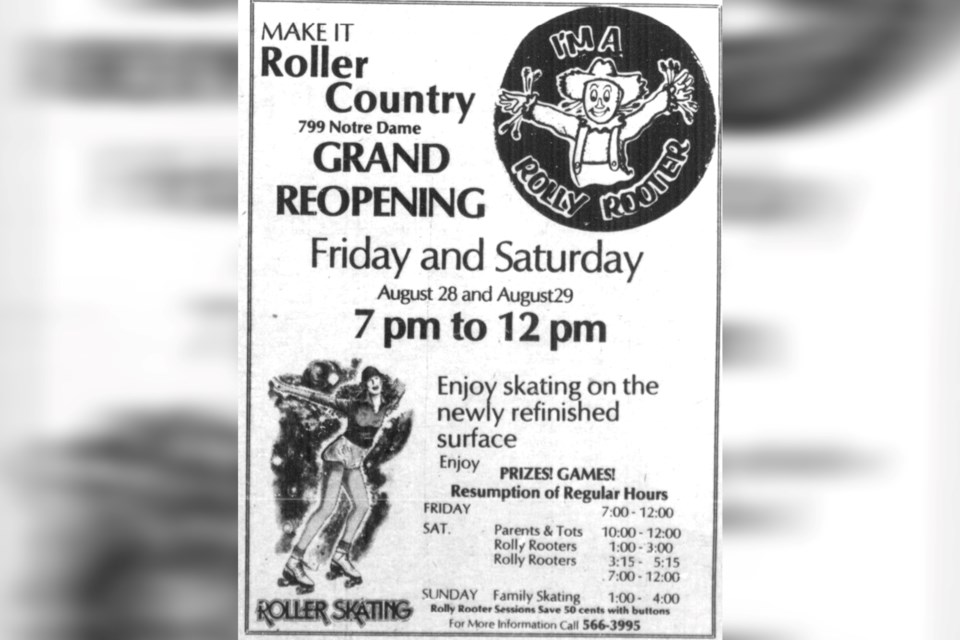
As Cecile Cloutier, the manager of Roller Country in 1977, stated in an interview at the time, that “parents leave us, with complete confidence, the responsibility of their children, young or old. Because of the regulations we impose, parents realize our good intentions, and that is why they trust us completely.” At Roller Country, there would be a minimum three-month suspension for anyone who broke the house rules.
If you were a Roller Country patron back in the day, you may remember (and may have even broken) some of these regulations. An anomaly for the time, no smoking was allowed inside the building. This made it a haven for non-smoking adults who would have had very few places to go without being overwhelmed by second-hand smoke.
From the management's point of view, the no smoking rule, as well as one prohibiting alcohol, would be necessary in order for the floor and all the trimmings at Roller Country to remain in good shape for the long run. Another no-no was gum. Once wrapped around a skaters’ wheels, that most innocent of Chiclets could wreak absolute havoc.
Other rules from back in the day are somewhat less understandable, including a prohibition on wearing hats, sweatbands and bandanas while rolling around the rink. It seems to me that a case of blurry vision from salty beads of sweat while whizzing around amongst a throng of 800 other roller-dancing fools would be more of a hazard than a head covering of any kind.
For those willing and able to follow all of the rules established on the signage upon entry, they would now be able to join their peers on the roller disco floor, some of whom were doing their best Linda Blair impersonation from the film “Roller Boogie” (as opposed to an impersonation of what she yelled at the priest in The Exorcist). She, with the special skates that looked like they didn’t have any laces, along with a series of absolutely rad leotards with tassels.
In August 1979, the rink hosted a skate-a-thon that lasted for 29 hours. The skate-a-thon began at 7 p.m. on a Friday evening with 90 participants involved in a continuous skate to see who could last the longest on eight wheels.
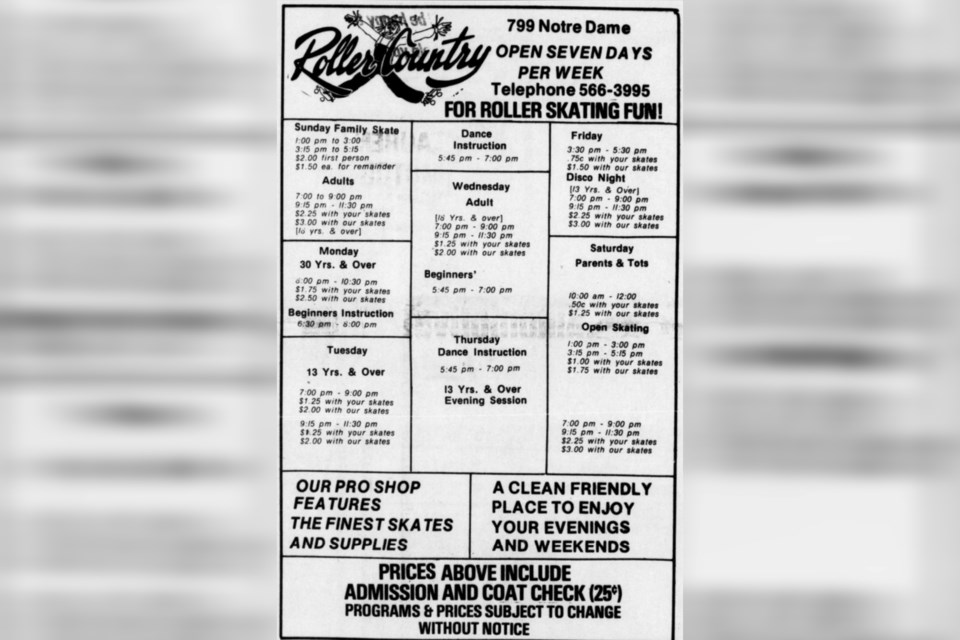
By midnight Sunday, the five women and two men still skating voted amongst themselves to end the marathon to their mutual satisfaction by splitting the prize money. Those completing the gruelling 29 hours and sharing first place were Carol Kirby, Kim Morrison, Annette Lauzon, Diane Chiasson, Michael Lalonde, Evalyn Churan, and Glen Bejczak.
In 1980, Roller Country was advertising several skating sessions, including expanded disco nights on Wednesday, Friday and Saturday evenings (come on out and groove to the sound of the best music in Canada), a session for parents and children every morning from 10 a.m. to noon and what was known as “Rolly Rooter” sessions during the afternoon on weekends.
During the teachers strike of that year, Roller Country was even open all afternoon daily for students who were waiting out a return to the classroom.
According to Desmond Kameka, the manager of Roller Country at that time, the price of entry was the lowest in Canada, which served to entice as many interested skaters as possible out to the rink. In addition, he was also pleased to offer roller-dance classes (specializing in disco, waltz, and freestyle) for both adults and children, in order to spread the good word about the fun of roller-skating.
As more people learned the skills of roller dancing, the rink would, at times, be the scene of “Roller Boogie” competitions where a dozen or so skating enthusiasts boogied down to a program set to music of their choice. Each person strutted their stuff to showcase their style and some of the tricks that they had learned, including quick steps with some fancy footwork, jumps and pirouettes.
In fact, some skaters showed such promise that they would attempt more competitive avenues within the sport.
In 1981, fifteen-year-old Andrew Udeschini was one of those skaters. He parlayed his time on the rink into competitive glory when he emerged a winner at the Ontario Provincial Federation of Amateur Roller Skaters competition held in Waterloo.
Udeschini wheeled his way to victory and a gold medal in the Novice B Freestyle
class. He was the only person from Sudbury to capture a medal at the competition. In fact, he was the only Sudburian at the meet.
Unfortunately, in order to compete, Udeschini was forced to register with a Waterloo roller skating club since the provincial federation would not recognize the Roller Country Freestyle Club, of which he was a member.
Regrettably, as the 1980s wore on and recreational habits changed, a night out at Roller Country (just as with our local drive-in theatres) became a thing of the past. Its place at the centre of youth culture in this city quickly faded from the public’s consciousness.
By the start of the 1990s, the building was sitting vacant, yet the memories that it contained still held on strong with those who enjoyed it during its lamentably short heyday.
Well dear readers, now it’s your turn to roll out your memories for us. Was Roller Country your Xanadu? Did you work there dishing out skates, playing the groovy music or rescuing nervous skaters? Did you meet your future husband/wife among the rolling throngs? Or, maybe you competed in one of the dance-a-thons or boogied your way to a prize in a dance competition. Share your memories and/or photos by emailing them to Jason Marcon at [email protected] or the editor at [email protected].
Jason Marcon is a writer and history enthusiast in Greater Sudbury. He runs the Coniston Historical Group and the Sudbury Then and Now Facebook page. Memory Lane is made possible by our Community Leaders Program.
